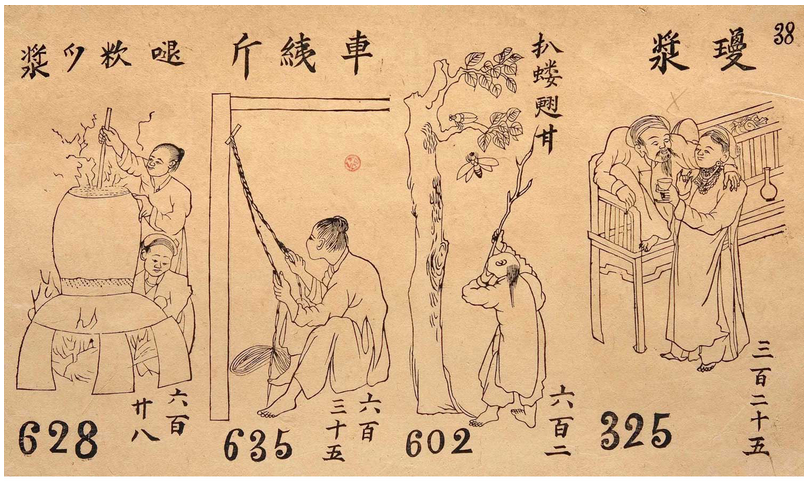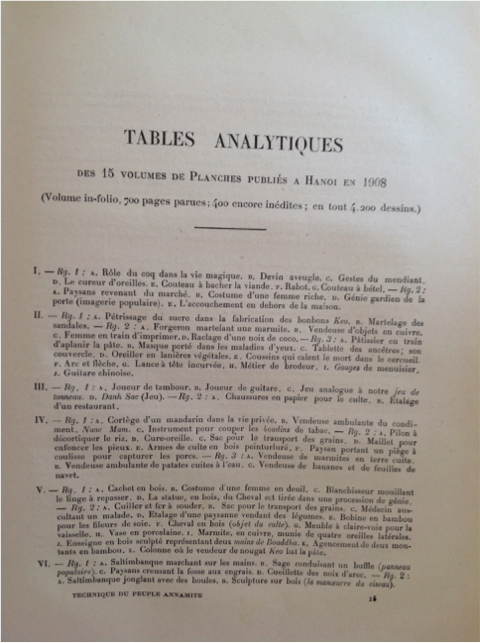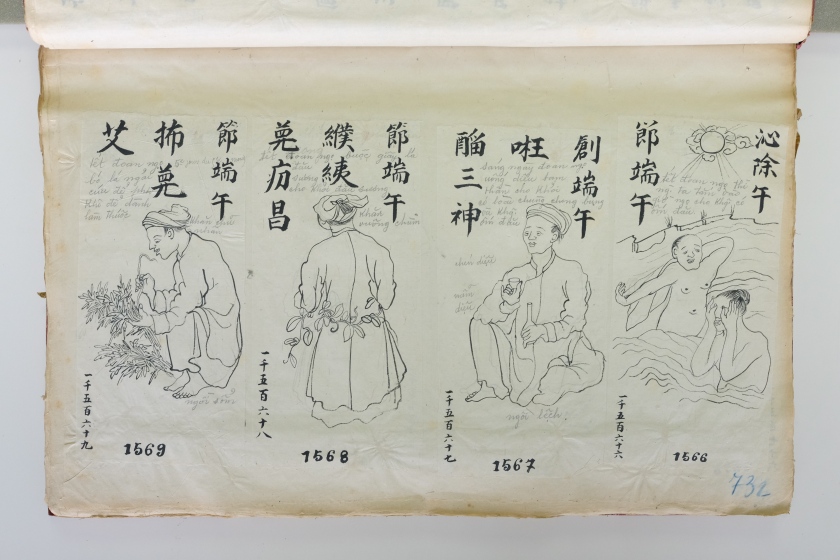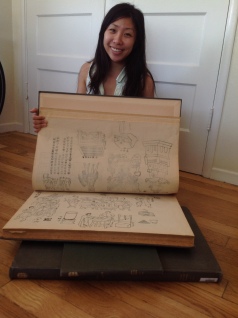It’s been nearly a year since I’ve stumbled upon the fascinating text Technique du Peuple Annamite (Mechanics and Crafts of the Vietnamese People) (Published 1908-1910). I had hoped to come to more of a conclusive analysis of this text before posting about this project. However like most intellectual projects, more questions and directions for analyses have opened up rather than converged into a neat finality. (See poster of tentative DH research presented at 2015 Berkeley DH Faire)
Thus, I wanted to at least share my initial observations and inquiry into the text. Below is a brief introduction to the text itself and excerpts (Methods & History of the Book) from my essay “On Examining a Peripheral Text: Technique du Peuple Annamite”, which I hope to finish editing and publish here. Additionally, I created a timeline of the life of the text and author below:
Introduction
Based on research conducted on the regions around Hanoi in 1908-1909, the French colonial administrator Henri J. Oger published the collection Technique du peuple Annamite (Mechanics and Crafts of the Vietnamese).[1] As a work of early ethnography of Vietnamese material technologies and cultural practices, Technique consisted of two main parts—an introductory essay titled Introduction Générale À L’étude de La Technique Du Peuple Annamite: Essai Sur La Vie Materielle, Les Arts et Industries Du Peuple Annamite (General Introduction to the study Mechanics and Crafts of the Vietnamese: Essay on the Material life, the arts and industries of the people of Vietnam) and 4,200 drawings with annotated captions written in Vietnamese demotic script (chữ nôm). The history of the production and transmission of the text reveal a complex narrative at the intersection of colonial institutions, social scientific professionalism, administrative policy, and knowledge on the colonies. Rather than converge neatly into a linear, tidy argument, the narrative of this text, its author, and the intellectual and political assumptions behind it carry its own narrative threads that at times overlap while other instances splinter off into equally plausible truths and temporary impasses. This essay pursues these uncertain argumentative threads and explores the social and ideological world in which these interpretations can be true.
To write and contain such an unorthodox essay, I follow the life history of both the text and author. Basic information regarding Technique and Henri Oger still remain uncertain, but by reading these two dimensions together this essay can reveal the unexpected and invaluable connections that hitherto have been subdued and generalized for narrative coherence. Some of these simplifications are due to attempts to classify the text as an ethnography, a work of art, or administrative document, and the author as a researcher, administrator, amateur orientalist, or intellectual. Through this essay, I demonstrate the failures of these rigid categories to fully comprehend the text and author who were always already considered peripheral within the historical milieu. Thus, central to this essay is the recognition that this text and author exist at the interstices of boundaries of genre, materiality, discipline, expertise, and profession.
PART I: HISTORY OF THE BOOK
This section weaves together the pieces of a complex history of the book of Technique and gives important attention to the ‘inescapable materiality of books’ in which its manufacturing, distribution, and preservation profoundly shaped its intellectual content as well its intellectual engagement by other scholars.[1] This section thus dedicates attention to the material constraints of the production of the text—a process that involved a draftsman, woodblock carvers, printer, bindery, publisher, and distributor—in order to answer the question of the intellectual production and marginalization of the text. Importantly, the story of Technique’s printing and distribution could not emerge without recognition of the many Vietnamese laborers involved in the production of the text. Although very little is known about these actors, reading against the grain of Technique for subtle nuances in style, exclusion, and expertise can begin to erode away its superficial construct as ethnographic truth. This history does not attempt to displace the excellent introduction to Oger and this work by Philippe Le Failler and Olivier Tessier from the 2009 edition of Technique, the recent articles in Nghiên Cứu và Phát triển (Research and Development) by Nguyễn Quảng Minh, Ngyễn Mộng Hưng, and H. Van Puten, and Nguyễn Mạnh Hùng’s research on the visual and material dimensions of Techniques.[2] Rather, it takes a history of the book approach and tries to understand the layers of technological processes, authorship, and circulation involved in the materiality of Technique.
Basic layout of Technique
Technique du peuple Annamite consists of two distinct parts: the Volume des planches (Volume of plates) and a Volume du texte (Volume of text). The Volume of plates consists of the 4,200 drawings printed in Hanoi in the summer of 1909 and the Volume of text, also referred to as Introduction Générale À L’étude de La Technique Du Peuple Annamite: Essai Sur La Vie Materielle, Les Arts et Industries Du Peuple Annamite (General Introduction to the Study of the Mechanics of the Annamese People: Essay on the material life, arts and industries of the Annamese People), was printed either in Paris sometime between March 1910 and the end of that year.[3]
The 4,200 drawings were originally woodblock printed using wooden ‘planches’ (plates) on paper made from the bark of the Daphne plant or mulberry tree.[4] The result was 700 numbered pages of drawings, with dimensions of 65 cm x 42 cm and each page printed only on one side.[5] Ranging from drawings of tools to activities, the illustrations appear to not be organized thematically except with the intention of filling the space of each page. On later pages, the illustrations are larger and more evenly spread out, usually with three to four illustrations per page. The drawings usually are placed along one to three rows on each page. Many of the illustrations have a caption written in Nôm characters on the top of it, and at times Chinese is used as well.[6] Some of the drawings are numbered in Chinese and with a romanized number below the drawing itself.


In Introduction générale, Henri Oger explains in detail his methods for his ethnographic study and visual compendium, Technique du Peuple Annamite. He also presents a “Tables Analytiques des 15 volumes de Planches publiés a Hanoi en 1908” (“Index of Illustrations for the 15 volumes of plates published in Hanoi in 1908”). Below the title he writes “700 pages published; 400 unpublished; 4,200 drawings in all”. (See Figure 1-3) The captions are organized by page, and listed by row describing drawings from right to left. For example, Oger’s captions for the drawings on page five are presented in the following way:
- – Row 1 : A. Wooden seal. B. Outfit of a woman in mourning. C. Laundress wetting laundry to be ironed. D. Wooden statue of the horse pulled in a procession of deities.
– Row 2 : A. Soldering iron and spoon. B. Sack to carry seeds. C. Doctor sounding the chest of a patient. D. Display of a peasant selling vegeTables. E. Bamboo spools for silk spinners. F. Wooden horse (object of worship). G. Open work cabinet for dishes. H. Porcelain vase. I. Copper pot with four lateral handles. J. Sculpted wood sign depicting the two hands of Buddha. K. Arrangement of two bamboo uprights. L. Post against which the seller of kẹo nougat pounds the paste.
Material Production: Woodblock Carving and Printing of the Ethnographic Sketches
During Oger’s period of military service in Tonkin in 1908-1909, Henri Oger conducted his ethnographic study of Hanoi and its surrounding regions.[8] Occupied with administrative and military duties, Oger most likely relied upon several collaborators, including a Vietnamese draftsman, to help him to compile and print this work. In Introduction générale, Oger explains that he had set up two workshops of thirty Vietnamese woodblock carvers in cái đình (temple) on rue de Chanvre and and Vũ Thạch pagoda. [9] After two months of struggle, 4,000 blocks were completed and ready for printing. However, he remarked that by that time, the summer heat had warped the machinery and rollers and thus he relied upon Chinese and Vietnamese printing methods. After this decision, Oger characterized the materiality of the project in Introduction générale, “This work reinforces the book’s strong, local flavor. Everything is Annamite.”[10]

This shift in printing method could be the reason for the randomized layout of most of the printed illustrations on the pages. Philippe le Failler and Olivier Tessier also hypothesize that the lack of order for each plate could have been determined by the woodblock carver before the actual printing.[11] At the same time, only approximately the first 190 pages contain drawings that appear crowded and disorderly, while later pages are more evenly spaced apart with three or four drawings on each page. This could be the result of the differing approaches to printing at each workshop. Some pages are also more thematically organized, such as Page 182 where most of the drawings were concerned with visual imagery.
During this period, it was common for the woodblock carver to also complete the printing of a work, and Oger could have commissioned the drawings of Technique to be completed in this way. His process of engraving and printing most likely included the carving of designs onto a planche (wooden board or plate) and the overlaying of a paper made out of the bark of the mulberry tree (giấy dó) or Daphne tree over the boards. Oger remarks that the papermakers from the Paper Village (Làng Bưởi) near Hanoi meticulously constructed the large-sized paper by hand, only using simple tools and a mold. According to Fred Siegenthaler’s study on Vietnamese hand paper-making and woodblock printing, stamp prints were impossible with wooden printing blocks because of the humid climate of Vietnam.[12] Vietnamese woodblock printing, and most likely the engraving and printing of Technique, involved the following steps: first, the paper is pre-coated with a base or ground color to make it less absorbent; second, the engraved woodblocks are dipped in ink; third, the engraved woodblocks are placed vertically and lightly pressed on the sheet of paper; finally, with the paper stuck to the block, the block is turned over and the printer rubs the back of the paper with a sponge until the ink transfers evenly to the paper. The second to fourth steps are repeated for each color required for the final print.
According to Introduction générale, the volume of drawings were printed in-folio, which could mean that the sheets of paper were printed and then folded in half to produce two leaves. The text Introduction générale, however, was printed on thirty-two planches in quarto, where a sheet is printed, folded, and cut into fourths resulting in each page to be approximately 22 cm by 28 cm in size.[13]
Binding and the Current Versions of Technique
Based on the current holdings of Techniques, Techniques was probably only printed with a short print run of 15 to 60 copies either in Hanoi or Paris. Since the volumes of drawings were initially printed in Hanoi by woodblock, they were not officially filed into the French library according to the copyright jurisdiction depòt legale. This complicates the history of Technique since it was printed in different times and locations and was not officially registered as a complete work in the French national library.[14] Currently, slightly different versions and incomplete parts of the original print run currently exist in libraries in Vietnam, London, Japan, Paris, as well as in the university libraries of University of California, Berkeley; Johns Hopkins University, Baltimore; Southern Illinois University, Carbondale; and Cornell University in microfilm.[15] The process of engraving, printing, and binding, spans several continents and even today, information regarding the various stages of production and acquisition of the text are still being pieced together. In particular, analyzing the various ways in which Technique was bound can shed light upon the material state of Technique’s circulation.[16] By examining the existing versions of the text, we can better understand both the production, circulation, and level of influence Technique might have had, and also the vision and level of involvement of Oger at certain stages of production and dissemination.
In the 2011 article “Vài điều mới biết về bộ sách Kỹ Thuật của người Nam (A few more details just discovered regarding Techniques and Mechanics of the Vietnamese) by Nguyễn Quảng Minh, H. Van Putten, and Nguyễn Mộng Hưng, the authors note the slight differences between the versions currently held in libraries and archives in Saigon, Hanoi, London, and Japan.[18] The authors note in particular the binding of the versions and the different ways in which the cover page titled “PLANCHES” (plates) differed in its printing and paper. According to this examination by Nguyễn Quảng Minh et al., the detailed differences between the versions could shed light upon the many phases and locations where Techniques was initially printed.[20]

The variations in binding and completeness of the current holdings of Technique raises the question of Oger’s level of involvement in the shipping and binding of the text as well as reaffirms that Technique’s production spanned both time and space. Although the Volume of Planches was initially printed in Hanoi in 1909 and temporarily bound in varying sizes, it is possible that this volume was reprinted in France around the time the Introduction générale was printed in 1910 in Paris. According to the Introduction générale, the Volume of Planches would consist of 15 fascicules (booklets) that constituted one volume printed in folio–the largest type of book, usually 15 inches or more in height. As explained in the Introduction générale, this Volume of Planches would be the second volume to the Volume of Text. However, the differences in the actual binding of the booklets and what is explained in the Introduction générale demonstrates the historically decentralized way in which books were printed and bound. Furthermore, the difference between the actual and intended binding suggests that Oger possibly lost interest in or was unable to gain support for the project after the printing of the drawings in 1909 and printing of the Introduction générale in 1910. The absence of Oger’s other publications, (which he listed in his list of forthcoming publications included in Introduction générale,) support the notion of Oger’s possible departure from Techniques and ethnographic scholarship writ large. However, Philippe le Failler and Olivier Tessier indicate that after 1910, Oger had in fact continued to pursue scientific side projects and they reference reports criticizing Oger’s increasing neglect of administrative duties.[22] Given this report and Oger’s divergence away from his proposed research projects, Oger’s attention to his administrative role and research projects remain ambiguous. Nevertheless, the material artifact of Technique as it remains today in libraries and archives around the world can suggest certain dimensions of Oger’s work ethic and interest. At the same time, the neglect and fragmented ways in which Technique circulated can also shed light upon the state of decentralized twentieth century colonial research.
[1] Simon Eliot and Jonathan Rose, A Companion to the History of the Book (Malden, MA: Blackwell Pub., 2007).
[2] Meticulously restored and translated, 2000 copies and 1000 DVD format of this trilingual edition of Technique du peuple was made in 2009. Published with a new introduction by scholars of the ÉFEO, Olivier Tessier and Philippe le Failler, this version provides invaluable context and translations of the chữ nôm captions into modern day Vietnamese (chữ quốc ngữ).
Philippe le Failler and Olivier Tessier, “Preface,” in Technique Du Peuple Annamite Mechanics and Crafts of the Annamites = Kỹ Thuật Của Người An Nam, vol. 1, 3 vols. (Hanoi: École française d’Extrême-Orient, 2009), 118–36.
[3] I am able to narrow down that the introductory essay was published sometime between March 1910 and the end of that year based on some assumptions drawn from the dates on the list of publications and from the page “List of Works by the Author”.Henri Oger, Introduction Générale À L’étude de La Technique Du Peuple Annamite: Essai Sur La Vie Materielle, Les Arts et Industries Du Peuple Annamite (vol. 1. Texte.-Vol. 2-3 Album de 4000 Dessins, Plans et Gravures) (Paris: Geuthner Libraire-Editeur, 1910).
[4] Influenced by Chinese papermaking, Vietnamese papermaking also used the bark of the daphne tree that was native to Vietnam and its neighboring regions. The earliest record of Vietnamese access to Chinese books in the eleventh century, and most likely acquired papermaking and printing techniques around the same period. Tsien Tsuen-Hsuin, Science and Civilisation in China: Volume 5, Chemistry and Chemical Technology, Part 1, Paper and Printing (Cambridge University Press, 1985) p. 350.
[5] Depending on the version of Technique, there is slight variation of the number of drawings and pages.
[6] Nôm script is based off the use of classical Chinese characters to render Sino-Vietnamese and Vietnamese words. While literary Chinese was used for official documents up until the twentieth century in Vietnam, Nôm was often used for folk work and literature, such as the famous Tale of Kiều. Romanized script was later implemented in the beginning of the twentieth century more broadly as part of colonial policy to culturally isolate Vietnam away from Chinese influence. For brief remarks on the use and translation of character script in the 2009 edition of Technique, Văn Nguyên Nguyễn, “Some Remarks on the Character Script Employed in the Present Volume,” in Technique Du Peuple Annamite Mechanics and Crafts of the Annamites = Kỹ Thuật Của Người An Nam, vol. 1, 3 vols. (École française d’Extrême-Orient, 2009), 109–11.
[7] The titles following a dash are subsections of the title before the dash. For example, Oger has a section on The Lacquerer, and following a description of the lacquerer he has subsection titled Techniques of the Lacquerer.
[8] During the French colonial period, Indochina consisted of five ‘petit pays’: Tonkin, Annam, Cochinchine, Laos, and Cambodge (modern day North, Central, and South Vietnam, Laos, and Cambodia).
[9] According to the Viện Từ Diển Bách Khoa (Encyclopedic Dictionary) these images were most likely printed in Cổ Vũ on Hàng Gai and Vũ Thạch temple on Hàng Giò (presently Bà Triệu street in Hanoi). According to Hoa, much of early printing in Vietnam were initiated in temples where liturgical and scriptural texts formed much of the early texts. Bằng Hoa, “Kỹ thuật ấn loát của thời xưa,” Nghiên cứu lịch sử, no. 133 (July 1970): 52–55.
[10] Oger, Introduction Générale À L’étude de La Technique Du Peuple Annamite: Essai Sur La Vie Materielle, Les Arts et Industries Du Peuple Annamite (vol. 1. Texte.-Vol. 2-3 Album de 4000 Dessins, Plans et Gravures).
[11] le Failler and Tessier, “Preface.”
[12] Fred Siegenthaler, Vietnamese Hand Papermaking and Woodblock Printing, trans. Catherine Gekeler-Chalmers (Muttenz, Switzerland: Paper Art, 2003). Siegenthaler includes more details on the processes of making inks, paper, and printing, and includes beautiful paper and print samples from the famous woodblock printing village Dong Ho located just 40 km outside of Hanoi.
[13] A volume printed in ‘quarto’ is usually about 9 inches by 12 inches, or the size of an A sheet folded in fourths. Quarto sized paper is also called eight-page signature. Note the page for the Tables Analytiques (Figure 1-3) where sheet number “15” is printed on the bottom right corner of the page. Every fourth leaf in this text is numbered which demonstrates that a larger sheet was printed in quarto.
[14] Today the Bibliothèque nationale de France (National Library of France, located in Paris) seems to own only
the second volume of drawings. However the catalog for this source contains conflicting information such as the dimensions and page numbers of a volume of drawings, and also the title and publication location information generally used for the Volume of Text for the Volume of Plates.
[15] The 2009 edition is based off of the current version of Techniques held at Thư viện Khoa học Tổng hợp Thành phố Hồ Chí Minh.
[16] It is important to note that books could be sold as flat sheets or bound in thinner boards, and the individual could choose to bind the text for durability. For more information on the history of bookbinding see, Rob Banham, “The Industrialization of the Book, 1800-1970” in Eliot and Rose, A Companion to the History of the Book.
[17] Nguyễn Quảng Minh has posited that the ambiguity and lack of structure for the printing was due to miscommunication between Oger and the printers. Aside from the haphazard way in which the drawings are printed, Minh also argues that the varied lengths of each booklet could also be evidence of the lack of communication and foresight by Oger to plan the printing of the drawings. For extensive comparisons between these versions, see Nguyễn Quảng Minh, Puten H., and Nguyễn Mộng Hưng, “Vài điều mới biết về bộ sách Kỹ thuật người Nam/A New Perspective On the Book Technique du peuple Annamite,” Tạp chí Nghiên cứu và Phát triển 0, no. 5(88) (October 31, 2011): 128–42. P. 132.
[18] The British Library in London also has one edition that the 2009 version does not mention. Minh explains that this version includes a volume of text and two parts of a volume of plates, with one volume with a page labeled “PLANCHES” printed in typo on thick, green paper, and printed in a similar format to the version in Hanoi. According to Dr. Sud Chonchirdism of the Trưởng Ban Sưu tập Việt Nam the British Library purchased this set on March 1923.
[19] Nguyẽn Mạnh Hùng regarded the Hanoi version to be an incomplete set of 7 unevenly bound volumes in his 1989 study. However, the authors of the recent study “A few more details…” consider the Hanoi version to be the most comprehensive and invaluable. At the time, and still today, only two full sets and one single volume of the original print run exists in Vietnam. Apparently the 2009 survey of existing versions also found the Hanoi version inadequate and instead based the 2009 edition on the copy in Ho Chi Minh City. Printing by ‘typo’ refers to either a distinction from woodblock printing or the typographic printing using machine rollers.
[20] For example, the authors were able to conclude that the white pages with the hand written dedication must have been printed sometime between December 29, 1910 and March 24, 1912 because of Oger’s signature as èlève administrateur in the Services Civils in Indochina. For further information, reference the Tables and highlighted comparisons between the versions in the article Minh, Puten, and Hưng, “Vài điều mới biết về bộ sách Kỹ thuật người Nam/A New Perspective On the Book Technique du peuple Annamite.”
[21] The version at University of California Berkeley contains both the Volume of Text and the Volume of Plates and has an insignia in the Volume of Text that establishes the texts as part of the Collection of Horace Carpentier. Carpentier (1824-1918) was the first mayor of Oakland (1854-1855) and according to the collections in the UC Berkeley library, also donated several rare works on China.
[22] le Failler and Tessier, “Preface.” Le Failler and Tessier reference Oger’s administrative file located in the Centre des Archives d’Outre-mer, at Aix-en-Provence, and at Centre No 1 of the National Archives of Vietnam in Hanoi. P. 116-117.





Thanks for this. I have the 2009 book which is fascinating but the story of the books making is very curious. I bought the book in order to further our studies of the Dieu Sao flute kites. (Uli Wahl and myself authored a small book on the Dieu Sao that has found itself on the Internet in .pdf form without our permission!)